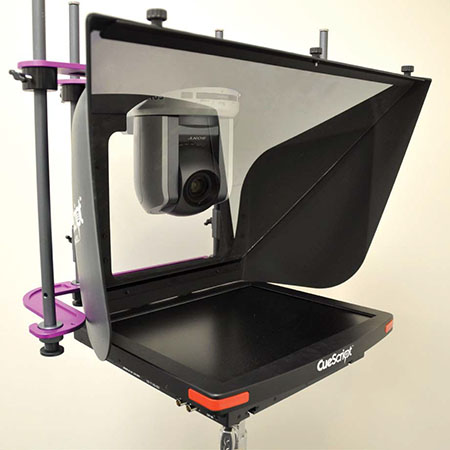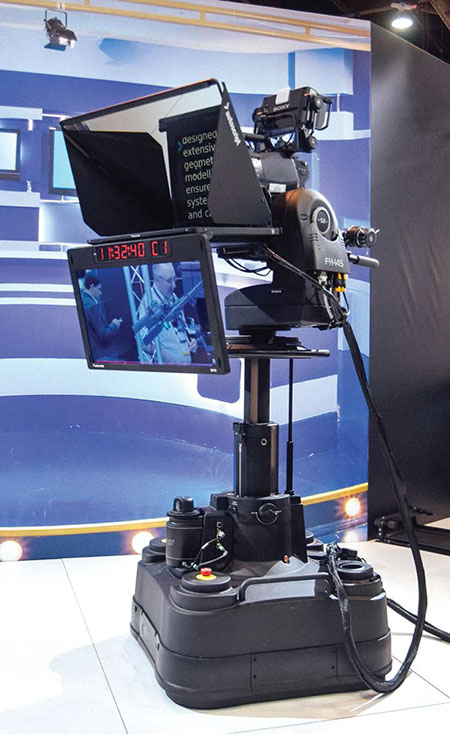Prompters: Ready for the IP Revolution?
SEATTLE—If you ever start taking the teleprompter system in the news studio for granted, just watch what happens when it goes down: you’ll see mayhem followed by finger pointing and yelling. The teleprompter is mission critical.
Along with the rest of a studio’s infrastructure, teleprompters are now increasingly IP-based. A fully IP prompter system would be connected by nothing but CAT5 cables riding on a network. Instead of feeding video to the prompter monitor, data is fed to it and the monitor makes its own video, which it displays. Among the advantages to this is that there’s no issue with different formats and video cables. And anywhere you can get to the network, you can have a scrolling controller, even if it’s half way around the world.
NOT A ‘SEAMLESS SOLUTION’
CueScript and the two Vitec Group teleprompter brands, Autoscript and Autocue, have been working on IP prompter systems in their arsenals for several years (editor's note: updated from print version of this story).

CueScript’s PTZ Prompter System
“IP is certainly a growing trend,” said Vitec Group product marketing manager Ginny Grove. “And we’re seeing it globally, it’s something customers are moving to or aspiring to. It never has been a seamless solution, however. Somewhere you always end up with another cable being required.”
It’s still a little early, agreed Michael Accardi, president of CueScript. Although a few facilities have built all IP infrastructures, including prompters, just to show they could do it, “broadcasters in 99 percent of the cases are not ready for an all-IP prompter system. They may have IP prompter screens and controllers, but if their multi-viewers aren’t IP ready, then they’ll need a video box to generate video for that. Just because my prompter monitors can take a CAT5 cable doesn’t mean my whole facility can take it.”
Both companies are building hybrid components that sport a variety of input jacks, including CAT5. This allows the facility to migrate to IP on their own schedule. “We don’t want to cut out our existing customers, existing facilities,” said Grove. “So we’re maintaining a video structure alongside the IP structure, so people can transition as they want.”
Get the TV Tech Newsletter
The professional video industry's #1 source for news, trends and product and tech information. Sign up below.
Both companies have wireless scrolling controller solutions available, but have steered clear of Wi-Fi or Bluetooth connections at this time; it’s a matter of trusting those technologies. As noted earlier, prompting for live television production is mission critical.
This slow rollout of fully-IP prompter systems has allowed prompter makers to refine their systems without the pressure of equipping the entire industry with the technology today. “We’ve had our baptism, we know what the firewalls are like, we know nets and subnets, and security at different facilities,” said Accardi.
TABLETS AS AN OPTION
“We’ve noticed a steady rise in the number of people that want to use an iPad or tablet for teleprompting,” said Mike Burdick, sales manager for Mirror Image in Oshkosh, Wis., which has coupled tablets with components of the company’s professional prompter line. “We use the same wide-angle mirror, heavy-duty lens hood and fully adjustable camera mount as our high-end teleprompters.” He cautions that “although the ability to use the iPad or tablet as a teleprompter is an easy, cost-effective prompting solution, it does have some drawbacks.” Among the most obvious is that the screens are not bright enough to be effective when used for prompting outdoors. Though a tablet screen may be visible in daylight normally, it’s well to remember that when used as a prompter, the mirror will cut down light passing through it. For that kind of outdoor use, Burdick recommends at least a 1000 NIT day bright monitor. (A NIT is an amount of light output equal to one candela per square meter (cd/m2)).

Autoscript’s EPIC-IP 19XL teleprompter
Just back from NAB, Chris O’Brien, managing partner at Telescript International, said he’s seeing that “everything’s getting smaller, especially robotics and robotic cameras. So we make monitors for prompters specifically for robotic cameras.”
It’s a problem of achieving the right balance of the monitor and the new, smaller cameras. Customers want the same-size monitor and mirror assembly so that the anchors can read scripts alright. But that can make the payload on the robotic head front-heavy. “We take the electronics out of the front end of the monitor and stick it onto the back,” said O’Brien. “This allows us to significantly reduce the weight of the payload because we don’t have to put a counterweight back there.”
One challenge that prompter makers are running up against is mounting prompting systems onto the small PTZ cameras. The panning and tilting motors on PTZs are so small that they can’t perform smoothly when trying to carry the monitor assembly along with the camera.
O’Brien’s solution for PTZ prompting is a fold down design that can be erected when prompting is needed, “and when you don’t need the teleprompter you can fold down the teleprompter glass and hood, and you can actually gain a lot more of the PTZ panning and tilting because the teleprompter isn’t in the way.”
Teleprompters are likely to change a lot in the next decade.
